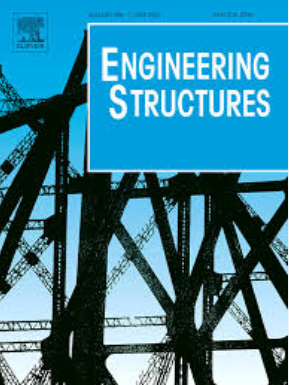Investigation on vortex-induced vibration control of streamlined box girder by small-scale horizontal axis wind turbine and its energy harvesting potential: An experimental study at large angle of attack
IF 5.6
1区 工程技术
Q1 ENGINEERING, CIVIL
引用次数: 0
Abstract
With the increasing impacts of climate change on the wind speed, wind-induced vibrations of large-span bridges have become a significant challenge, especially for frequently occurred vortex-induced vibration (VIV). Effective control strategy of such vibrations is crucial for ensuring the long-term safety of bridges. Although previous studies have investigated the control effects of aerodynamic control measures, including passive and active strategies, it is still lack of explorations on the comprehensive design that combine control efficiency and energy potential. Considering the needs for sustainable development of infrastructure, this study proposed a conceptual design of bridge-integrated wind energy system through the installation of small-scale wind turbine, with the aim of combing both effective VIV control and utilizing the abundant green energy around. Through wind tunnel tests at large angle of attack (AoA), the difference of control effects under various arrangement was compared by considering shape and positional parameters. And the possible control mechanism and energy potential were probed by analyzing the results of wind pressure, wake and rotation speed respectively. This study shows that bridge-integrated wind turbine system contributed to the mitigation of vertical VIV phenomenon. And the turbine wake interfered the frequency and energy distribution during VIV, while reduced the wind pressure fluctuations around windward side of girder. While preliminary results of TSR support the energy potentials for above conceptual design, it still needs for further investigations on variable performance of energy output, as well as validating the possible negative effects may bring into bridge structures.
小型水平轴风力机流线型箱梁涡激振动控制及其能量收集潜力研究——大迎角试验研究
随着气候变化对风速的影响越来越大,大跨度桥梁的风致振动已成为一个重要的挑战,特别是频繁发生的涡激振动(VIV)。有效的振动控制策略对保证桥梁的长期安全至关重要。虽然已有研究对气动控制措施的控制效果进行了研究,包括被动策略和主动策略,但缺乏将控制效率与能量潜力相结合的综合设计的探索。考虑到基础设施可持续发展的需要,本研究通过安装小型风力发电机组,提出了一种桥式一体化风能系统的概念设计,目的是将有效的VIV控制与利用周围丰富的绿色能源相结合。通过大迎角风洞试验,在考虑形状和位置参数的情况下,比较了不同布置方式下控制效果的差异。通过对风压、尾迹和转速结果的分析,探讨了可能的控制机理和能量势能。研究表明,桥式集成风力机系统有助于降低垂直涡激振动现象。涡轮尾迹干扰了涡激振动时的频率和能量分布,减小了梁迎风侧的风压波动。虽然TSR的初步结果支持上述概念设计的能量潜力,但仍需要进一步研究能量输出的可变性能,并验证可能给桥梁结构带来的负面影响。
本文章由计算机程序翻译,如有差异,请以英文原文为准。
求助全文
约1分钟内获得全文
求助全文
来源期刊

Engineering Structures
工程技术-工程:土木
CiteScore
10.20
自引率
14.50%
发文量
1385
审稿时长
67 days
期刊介绍:
Engineering Structures provides a forum for a broad blend of scientific and technical papers to reflect the evolving needs of the structural engineering and structural mechanics communities. Particularly welcome are contributions dealing with applications of structural engineering and mechanics principles in all areas of technology. The journal aspires to a broad and integrated coverage of the effects of dynamic loadings and of the modelling techniques whereby the structural response to these loadings may be computed.
The scope of Engineering Structures encompasses, but is not restricted to, the following areas: infrastructure engineering; earthquake engineering; structure-fluid-soil interaction; wind engineering; fire engineering; blast engineering; structural reliability/stability; life assessment/integrity; structural health monitoring; multi-hazard engineering; structural dynamics; optimization; expert systems; experimental modelling; performance-based design; multiscale analysis; value engineering.
Topics of interest include: tall buildings; innovative structures; environmentally responsive structures; bridges; stadiums; commercial and public buildings; transmission towers; television and telecommunication masts; foldable structures; cooling towers; plates and shells; suspension structures; protective structures; smart structures; nuclear reactors; dams; pressure vessels; pipelines; tunnels.
Engineering Structures also publishes review articles, short communications and discussions, book reviews, and a diary on international events related to any aspect of structural engineering.
 求助内容:
求助内容: 应助结果提醒方式:
应助结果提醒方式:


